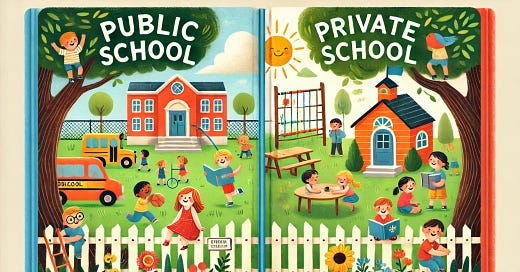Have you ever wondered why some kids go to different schools? Maybe you’ve heard someone talk about “public schools” and “private schools” and asked, “What’s the difference?” It’s a great question! Let’s explore what public and private schools are, how they’re similar and different, and whether one is better than the other.
Hello my friends!
For a quick note, welcome to Tidbits with Titus, a podcast and newsletter where we tackle the big, curious questions kids ask every day in fun, bite-sized ways! I’m Alexander Titus, but I go by Titus. I’m a scientist, adventurer, and a huge fan of making science, technology, and life accessible to all ages. From “How does electricity work?” to “What are taxes?” and even “Why is the sky blue?” I’m here to dive into these wonder-filled questions with engaging stories and simple explanations that spark curiosity and make learning a joy. This effort is all about creating a space where families can learn together, discover the magic of the every day and find thoughtful ways to explore the world’s big mysteries. Let’s make curiosity a family tradition—one tidbit at a time!
Just so you know, these podcast episodes are all AI-generated using Google’s really cool NotebookLM technology. That means there are some errors in how words are said, but that is part of the fun!
If your little ones have questions that you want help answering, shoot me an email at questions@tidbitswithtitus.com and I’ll see what I can do!
Also please share with anyone you think would be interested. The more the merrier!
Cheers,
-Titus
P.S. A special thank you to Cora for today’s question!
What Is a Public School?
A public school is a school that is run by the government. These schools are paid for by taxes, which are the money people give to the government to help pay for things like roads, parks, and schools. Public schools are free for all kids to attend.
Who Can Go to Public Schools?
Public schools are open to everyone who lives in the area, usually a neighborhood or town. Kids who live nearby can go to the public school closest to their home. This means you might go to school with your neighbors or kids who live down the street.
Who Runs Public Schools?
Public schools are run by school districts. These are groups of schools in a certain area, like a town or city. The government helps make rules about what public schools teach and how they run.
What Is a Private School?
A private school is a school that is not run by the government. Instead, private schools are paid for by the families of the students who go there. Families pay tuition, which is like a fee for attending the school. Sometimes, private schools get extra money from donations or from groups that support them.
Who Can Go to Private Schools?
Private schools can choose who gets to attend. Families usually apply to the school, and the school decides if the student can join. This means private schools might be smaller and have fewer students.
Who Runs Private Schools?
Private schools are run by independent groups, like churches, organizations, or even a group of people who started the school. They don’t have to follow the same rules as public schools and can decide what to teach and how to teach it.
How Are Public and Private Schools Similar?
Even though public and private schools are different in some ways, they have a lot in common too:
Both Help Kids Learn: Both public and private schools teach kids important subjects like math, reading, and science.
Both Have Teachers: Both types of schools have teachers who help students understand and practice new skills.
Both Have Rules: Every school has rules to keep students safe and make sure everyone can learn.
Both Have Activities: Public and private schools often have sports teams, art programs, and clubs for students to join.
How Are Public and Private Schools Different?
Now let’s look at some of the ways public and private schools are different:
1. Cost
Public Schools: Free for everyone because they are paid for by taxes.
Private Schools: Families pay tuition to send their kids to these schools. Some private schools offer scholarships to help families pay.
2. Rules and Curriculum
Public Schools: Follow rules set by the government. They teach subjects based on state guidelines, like math, reading, and science.
Private Schools: Can make their own rules and choose what to teach. Some private schools focus on religion, special subjects, or unique teaching styles.
3. Class Size
Public Schools: Might have larger classes because they take all kids in the area.
Private Schools: Often have smaller classes, which can mean more one-on-one time with teachers.
4. Teachers
Public Schools: Teachers need to have a teaching certificate from the state.
Private Schools: Teachers don’t always need a state certificate, but they usually have other training or experience.
5. Diversity
Public Schools: Have kids from many different backgrounds because they’re open to everyone in the area.
Private Schools: Might have fewer students or kids from specific groups, like a religious community.
Is One Better Than the Other?
The answer depends on what works best for each student and family. Let’s look at the pros and cons of each type of school:
Public Schools
Pros:
Free for all families.
Open to everyone in the area.
Often have a wide variety of classes and activities.
Cons:
Larger class sizes might mean less individual attention.
Fewer choices about what to teach because they follow government rules.
Private Schools
Pros:
Smaller class sizes can mean more personal attention.
Schools can focus on special subjects or unique teaching methods.
Families can choose a school that matches their values or beliefs.
Cons:
Tuition can be expensive for families.
Not open to everyone.
Fun Facts About Schools Around the World
In Japan, kids help clean their classrooms and serve lunch to each other as part of their school day.
Some schools in Finland don’t give students homework so they have more time to play and relax at home.
In Australia, some kids learn in “School of the Air,” which is taught over the radio or the internet for students who live far from any schools.
In many countries, kids wear uniforms to school so everyone dresses the same.
The largest school in the world is in India and has more than 40,000 students!
Questions to Think About
Would you rather go to a big school with lots of students or a smaller school with fewer students? Why?
What kinds of classes or activities are most important to you in a school?
Do you think it’s important for schools to follow the same rules, or is it better for schools to decide for themselves?
What Did We Learn?
Public and private schools both help kids learn, but they do it in different ways. Public schools are free and open to everyone, while private schools charge tuition and can choose who attends. Neither is better than the other—what matters most is finding the right school for you and your family.
No matter what kind of school you go to, the most important thing is to enjoy learning and make the most of your education. School is a place to explore, grow, and discover all the amazing things in the world!














Share this post